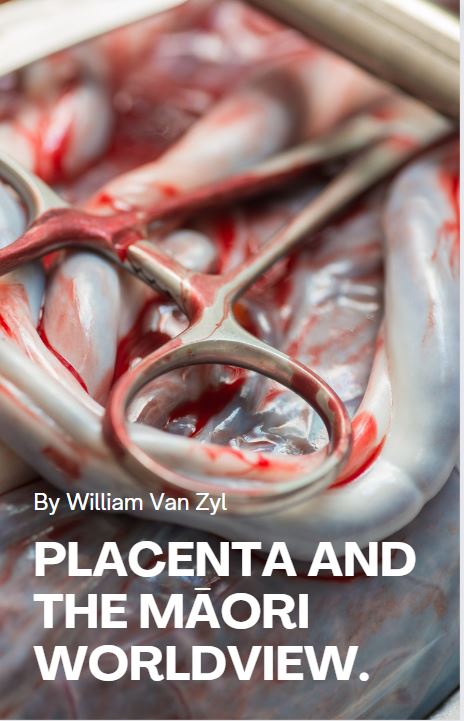
By William Van Zyl (Published 21 Aug 2023).
I provide a short overview and exploration of Māori and other cultures’ placenta practices worldwide. This short article/book provides a rich canvas for artists, designers, architects and Design and Visual Communication students (DVC). The article/eBook is also handy for the new curriculum 2024 New Zealand – NCEA Level 1. All subject areas can use this resource to understand the fundamentals of Māori culture (Mātauranga Māori). Can you think of spatial or product design ideas as you read the article? Art students, imagine what you could communicate through your art. Think about symbolism – the rich layers of meaning that you could include. Jot them down or make simple sketches in your sketchbook, visual diary, or notebook; you can explore and develop your conceptual ideas later. You could document your initial ideas and thoughts as you read the book. Are you a writer? Think about fiction and non-fiction. Any ideas that pop up, jot them down. This article or resource could spark new ideas for creative writing, stories, projects, artwork, sculptures, and more.
Table of Contents
Here are some of the keywords and key phrases:
Māori worldview
Holistic worldview – Interconnectedness
Harmony and balance – sustainable practice
Whenua (The Land)
Placenta
Cultural identity
Spiritual essence
Symbolic action
Bury placenta (stories, customs – way of living)
Intrinsically linked
Intertwined with the health of the Land
Stewardship
Mātauranga Māori (At its simplest, mātauranga Māori might be described as ‘Māori knowledge’)
ewe (placenta, afterbirth)
Artistic expression
Introduction:
In the Māori worldview, the concept of “whenua” holds a deep and multifaceted significance that extends beyond its literal translation as both “land” and “placenta.” This duality between the physical land and the placenta represents a profound connection between humans, their environment, and their cultural identity. The saying, “The land does not belong to Māori, but Māori belongs to the land,” encapsulates this relationship. It is as a reminder of the indigenous cultures’ deep wisdom and respect for the natural world. See the summary below.
Placenta Art. Source: Twitter – https://twitter.com/goodnessgather/status/600721189321969664
- Whenua as Land: In the Māori worldview, the land is not merely a physical resource or territory but is regarded as a living entity with its own spiritual essence. The land is viewed as an ancestor and a provider, encompassing natural features, resources, and the environment as a whole. This perspective fosters a deep sense of respect, responsibility, and reciprocity between Māori and the land. The land nourishes and sustains the people; caring for it in return is essential.
- Whenua as Placenta: The Māori tradition of burying the placenta in a significant place is a powerful symbolic act that reinforces the connection between a newborn child and the land. This act acknowledges the physical and spiritual connection between human life and the land and emphasises the idea of birth as a continuation of the ancestral lineage. By burying the placenta in a specific location, the child becomes intrinsically linked to that place, and this connection endures throughout their life.
- Rituals and Infant Care: The whenua (placenta) and umbilical cord received careful placement within tribal land. Once the baby reached the milestone of rolling over, a tohunga performed the tohi ceremony, gently sprinkling water over the child. In the ‘pure’ ceremony, karakia were chanted. Following this, the mother and child rejoined the tribe. Within the whānau, mothers and other members sang oriori to their infants, lullabies that wove together whakapapa (family tree), legends, and tribal history. As mothers concluded breastfeeding, some would occasionally apply bitter kawakawa sap to their breasts.
Wooden placenta bowl, Maori, New Zealand,1890-1925. Science Museum, London. Source: https://wellcomecollection.org/works/fes9mbtz
- Interconnectedness: The notion that “Māori belongs to the land” underscores human beings and their environment’s interdependence and inseparability. This perspective rejects the idea of ownership and instead emphasises the idea of belonging. It reflects the understanding that humans are an integral part of the natural world, and their well-being is intertwined with the health of the land.
- Cultural Identity: For the Māori people, the relationship with the land is central to their cultural identity. Their stories, customs, and way of life are deeply rooted in the landscapes they inhabit. The land is not just a physical backdrop but a repository of stories, knowledge, and spiritual significance. By acknowledging that Māori belong to the land, a sense of responsibility and stewardship is ingrained in their cultural ethos.
- Holistic Perspective: This concept also reflects a holistic worldview that values the interconnectedness of all things – human, natural, and spiritual. It promotes harmony and balance between people and the environment, encouraging sustainable practices that ensure the well-being of both present and future generations.
I include a short story – about a placenta – just for fun.
A unique placenta story:
Silver Chopsticks Miraculously Save Dong-Hyun’s Life.
Link to the story: https://fivehousepublishing.com/2021/12/02/silver-chopsticks-miraculously-save-dong-hyuns-life/
Link to the podcast: https://www.podbean.com/ew/pb-a6m27-1148599
Design ideas – PLACENTA ART.
IMAGE: The Māori word ‘whenua‘ means both land and placenta. By a longstanding custom, the placenta of a newborn child is buried on their tūrangawaewae (the territory to which they have ancestral rights), thus combining both meanings. This 1987 painting by Robyn Kahukiwa, ‘Te whenua, te whenua, engari kāore he tūrangawaewae’, comments on the suppression of this tradition by European-run maternity hospitals which once insisted on burning placentas. Credit: Te Ara (Encylopedia of NZ). https://teara.govt.nz/en/artwork/41188/burying-the-whenua-1987
IMAGE: Rancher (artist) gives new life to afterbirth by creating art from cow placentas. The cow placentas has been stretched over a metal frame in Emilie Mattson’s mixed media piece, The Treasure Box. (Matthew Rivard/Contributed). Credit: https://www.cbc.ca/news/canada/british-columbia/emilie-mattson-cow-placenta-art-1.6668343

IMAGE: Creative card announcing the birth of Manuella (or is it an invitation?). Date and time of birth are written around the placenta (circular shape). SPANISH/PORTUGUESE: Receptcionada = received. Bem Vinda = Welcome. Equipe do hosp. = hospital team. Dear reader look closely at the umbilical cord on the card. See the names included in the veins attached to the umbilical cord at the bottom? One of the words are: Felicidade = congratulations. Can you find it? A very creative idea for a card!
More practices around birth and the placenta: Exploring the beliefs of the different cultures from around the world:
“In 2010, medical anthropologists Daniel Benyshek and Sharon Young studied placenta traditions across 179 societies. Among the 109 communities that held placenta rituals, there were 169 different disposal methods, including burial, incineration, placement in a specific location, or eating the placenta. Many cultures believe that the placenta is a close relative to the child and attribute human qualities to the placenta. Ancient Egyptians and other cultures believed that the placenta was the child’s secret helper or guardian angel. In Cambodia, the placenta is considered to be the origin of the baby’s soul. Therefore, the burial place is surrounded by spiked plants to protect the baby’s soul from evil spirits. In many traditional communities, people believe that the condition of the placenta will predict the child’s future skills and abilities. Also, it is believed that improper handling of the placenta can affect the health of the mother or the child. Thus, rituals for the handling of the placenta must be performed precisely and with great care. Many of these rituals involve washing the placenta in a special liquid, wrapping it within certain fabrics or plants, placing it in a specific vessel, and burying the placenta in an appropriate location. Quite a few cultures believe that it is important to pick an auspicious place to bury the placenta. In Turkey, if parents wish their child to be devout, they bury the placenta in the courtyard of a mosque, whereas if they want their child to care for animals, they bury it in a stable. In Malaysia, after the placenta is prepared with salt and tamarind, it is buried along with books and pencils under the doorway of the child’s house. The Malay believe that following this tradition will ensure that the child will be hardworking and a good student. But in Ukraine, the beliefs were the opposite: the midwife must not bury the placenta in a doorway or any place where it would be stepped over, or the mother would become infertile.
The Maori people of New Zealand use the same word for placenta and land: “Whenua”. They believe that the placenta burial symbolises the connection between the newborn baby and mother earth.
On the Indonesian island of Bali, the native tradition is to enclose the placenta in a coconut shell and hang it from a tree in the village graveyard. It is believed this will protect the child from illness and misfortune. The village of Bayung Gede has become a tourist attraction due to the hundreds of placentas hanging in its graveyard. Indonesia’s Ministry of Education and Culture declared the cemetery a national heritage site in Oct. 2020.”
Credit: Liat Ben-Senior. To learn more, visit https://parentsguidecordblood.org/en/news/honoring-placenta-different-cultures

Liat Ben-Senior is a professional with an extensive educational and career background. She holds an MBA and an MSc in Human Genetics from the prestigious Sackler School of Medicine at Tel-Aviv University, Israel. With over 15 years of experience, Liat has excelled in the realms of Marketing and Digital Marketing, particularly within the Biotech and Life Sciences sector.
Her scientific expertise extends to immunology and molecular biology research, where she has contributed her knowledge and skills in academic and industry settings. She has spearheaded business development initiatives in her managerial roles and played a pivotal role in commercialising early-stage medical devices, cellular therapies, and minor molecule treatments.
For more than a decade, Liat served as the Business Manager at CReATe Cord Blood Bank. During her tenure, she dedicated her efforts to educating both expectant parents and healthcare professionals about the various cord blood banking options available within the Canadian market.
In 2020, Liat took on the role of Marketing Manager at Anova Fertility & Reproductive Health, continuing her commitment to empowering expectant parents. Her mission is to provide them with the information and knowledge they need to make well-informed decisions regarding their reproductive health and family planning.
To learn more about cord blood banking, visit Parent’s Guide to Cord Blood Foundation: at https://parentsguidecordblood.org/en/news/honoring-placenta-different-cultures
Are you a serious artist?
Look at the work of Frieda Khalo (famous Mexican artist). Caveat here, not suitable for young children. Search: ‘Frieda Khalo placenta.’
Christian beliefs and the placenta:
Let’s go a little deeper. How do Christians view the placenta? Christians believe that the Word of God is the ultimate authority on destiny – the placenta has no role to play. It is medical waste. It is the Lord that directs their lives. See the great scriptures on destiny below.
Proverbs 20:24
It is the Lord who directs your life, for each step you take is ordained by God to bring you closer to your destiny. So much of your life, then, remains a mystery!
Psalm 139:15 NKJV
My frame was not hidden from You, When I was made in secret, And skillfully wrought in the lowest parts of the earth.
Citation:
Van Zyl, W. (2023). Placenta and the Māori Worldview. Five House Publishing. https://fivehousepublishing.com/2023/08/20/placenta-and-the-maori-worldview/
Interested in more Māori resources on architecture, food, fashion, furniture, tools, worldview, AI, and more?
Search the blog posts: ‘Māori‘
Here are some examples of the many articles and resources available: Māori context (metalwork, woodwork, furniture, food, tools, worldview, placenta, AI, Modernist architecture [e.g. Le Corbusier – Villa Savoye/Philip Johnson – The Glasshouse/Mies Van De Rohe – House Farnsworth, and others], and much more).
Copyright © 2023 by William Van Zyl
Placenta and the Māori Worldview.
All rights reserved. This eBook/article or any portion
thereof may not be reproduced or used in any manner
without the publisher’s permission, except for using brief quotations in a book review.
Published by Five House Publishing (New Zealand)
First Publishing, August 2023
More eBooks and articles are available at https://fivehousepublishing.com/
More about the author at http://williamvanzyl.com/